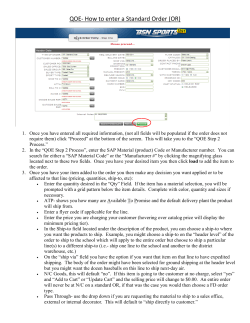
Sample Midterm I Key
Physics 135-1 Midterm, Spring 2014 Show all work for partial credit Name ________________________________ 1) (10 points) Suppose a ferris wheel with a radius of 3.5 meters is rotating clockwise at a rate of 5 revolutions per minute. The bottom of the wheel is elevated 1.75 m above the ground, as shown. Then, just as she reaches the very top of the wheel, a lady accidently drops her teddy bear. At what horizontal distance from the center of the wheel will the teddy bear hit the ground? Solution The ferris wheel is rotating at 5 / 60 = 0.08333 Hz, or = 2f = (2)(3.14159)(0.08333) = 0.5236 rad/s. This means that the teddy bear will leave the ferris wheel with a tangential (horizontal) velocity of v = R = (0.5236)(3.5) = 1.83 m/s. The teddy bear will fall (2)(3.5) + 1.75 = 8.75 m to the ground, and we can find out how long it falls from d = ½ gt2. That is, t = (2d/g)1/2 = [(2)(8.75) / 9.8]1/2 = 1.34 s. Therefore the teddy bear will drift (1.83)(1.34) = 2.45 m to the right from the center of the ferris wheel. 2) Two people are pulling on a barge in a river with ropes. One is pulling at 34° south of horizontal, and the other is pulling at 45° north of horizontal. The barge itself is moving only along the x-axis (horizontal). It has a mass of 200 kg. 2a) (5 points) If the barge is resisting their pull with 180 N of frictional force, and is gently accelerating at 0.2 m/s2, what is the tension in the north and south ropes? 2b) (5 points) Assuming the barge starts at rest, how much work (in joules) will the two people have expended after pulling on it for one minute in this way? Solutions 2a) The y-components of the tensions in the two ropes must balance, because the barge is not moving along the y-axis. Hence TN sin(45°) = TS sin(34°). The combined force of the two tensions along the x-axis must equal the friction plus “ma”, or 180 N + (200 kg)(0.2 m/s2) = 220 N. Hence we have TN cos(45°) + TS cos(34°) = 220 N. There are several ways to do the algebra from this point; we will set TN = TS sin(34°) / sin(45°) = 0.7908 TS to start, then substitute back into the second equation: 0.7908 TS (0.7071) + TS (0.8290) = 220, or TS = 158.5 N. This then yields TN = (0.7908)(158.5 N) = 125.3 N. 2b) The barge is accelerating at 0.2 m/s2, so after one minute it will have a velocity of v = at = (0.2)(60) = 12 m/s. This corresponds to a kinetic energy of E = ½ (200 kg)(12 m/s)2 = 14,400 J. In that same time it will have moved d = ½ at2 = ½ (0.2)(60)2 = 360 m. This corresponds to a work expended of W = Fd = (180 N)(360 m) = 64,800 J. So, the total work done is 79,200 J. 3a) (6 points) A rock A of mass 1 kg is moving at 40 m/s along the positive x-axis. Then it collides with another rock B of equal mass and ricochets away at a positive 30° relative to the x-axis. The second rock B moves away at a negative 45° relative to the x-axis. How fast is each rock moving after the collision? 3b) (4 points) How much heat is generated by this collision? Solutions 3a) Conservation of momentum along the y-axis means: (1 kg) vA sin(30°) = (1 kg) vB sin(45°), and similarly along the x-axis means: (1 kg)(40 m/s) = (1 kg) vA cos(30°) + (1 kg) vB cos(45°). The y-equation means that vA = 1.414 vB, and substitution of this into the x-equation gives 40 = 1.414 vB (0.866) + vB (0.707), or vB = 20.7 m/s. Thus vA = 29.3 m/s. 3b) The kinetic energy of rock A before the collision is E = ½ (1 kg)(40 m/s)2 = 800 J. The energies of the rocks after the collision are EA = ½ (1 kg)(29.3 m/s)2 = 429 J and EB = ½ (1 kg)(20.7 m/s)2 = 214 J, so by conservation of energy the heat released must be 800 – 429 – 214 = 157 J. 4) (10 points) A sphere of mass M = 5 kg and radius R = 40 cm has a cord tied around its equator, which is also attached to a small mass of m = 1.5 kg. The system is originally at rest. Then the small mass is released and allowed to fall. After it has fallen 50 cm, how fast (in radians per second) will the sphere be rotating? There is no friction in the system, and the pulley has no mass. Solution The gravitational potential released by the falling weight must equal the kinetic energies of the falling mass and the rotating sphere, so mgh = ½ mv2 + ½ I 2. We can relate v to with the formula v = R, and I for a sphere is 2/5 MR2. Thus mgh = ½ m2R2 + ½ (2/5 MR2)2. Inserting numbers: (1.5)(9.8)(0.5) = (0.5)(1.5)(0.4)22 + (0.2)(5)(0.4)22, or = (7.35 / 0.28)1/2 = 5.12 rad/s. 5) Assume that a frictionless cart of mass 4m is at the origin on a one-dimensional track. Assume that another cart of mass 2m is at x = 1 m and a third cart of mass m is at x = 2 m. The first cart is moving at v0 = 3 m/s; the other two carts are initially motionless. 5a) (5 points) Where is the center of mass of this system at t = 0? 5b) (5 points) Assume that the first cart collides with and sticks to the second cart, and then the second cart collides with and sticks to the third cart. Where is the center of mass of this system at t = 5 sec? Solutions 5a) Using the center of mass formula: xCM = [4m(0) + 2m(1) + m(2)] / (7m) = 0.571 meter 5b) After all the carts have collided and are stuck together, then conservation of momentum tells us that they must be moving at: (4m)(3 m/s) = (7m)v, or v = 1.714 m/s. That is, their CM must also be moving at 1.714 m/s. But, the motion of the CM cannot be affected by collisions between the different parts of the system, so this means that the CM was moving at 1.714 m/s before any of the collisions even happened and indeed, must continue to move at this speed regardless of whether the carts continue to stick together in the future or not! (Don’t you love physics?) So, at t = 5 s the CM must be at 0.571 m + (1.714 m/s)(5 s) = 9.14 m.
© Copyright 2025












